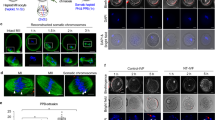Abstract
In Xenopus and other amphibians, there are two major classes of 5S RNA gene1. One class, which codes for somatic-type 5S RNA, is expressed in both oocytes and somatic cells2; the other, which is 50 times more abundant3 and which codes for oocyte-type 5S RNA, is expressed in oocytes but not in somatic cells2,4. The developmentally inactivated oocyte-type genes are reactivated when erythrocyte nuclei are injected into most oocytes (activating oocytes)5. As the injected nuclei are induced to take on the natural activity of the host cell, the activation of oocyte-type 5S genes may represent a normal control mechanism. A special opportunity to investigate this mechanism is provided by the existence of certain individual animals whose oocytes consistently fail to activate 5S genes (non-activating oocytes). We have injected extracts of activating or non-activating oocytes, together with erythrocyte nuclei, into oocytes of each kind. We show here that the transcription of 5S genes is induced by extracts of activating oocytes (positive regulation) and is not inhibited by similar extracts of non-activating oocytes. The activating factor is sensitive to protease and heat treatment, suggesting that a protein is involved.
This is a preview of subscription content, access via your institution
Access options
Subscribe to this journal
Receive 51 print issues and online access
$199.00 per year
only $3.90 per issue
Buy this article
- Purchase on Springer Link
- Instant access to full article PDF
Prices may be subject to local taxes which are calculated during checkout
Similar content being viewed by others
References
Brown, D. D. & Sugimoto, K. Cold Spring Harb. Symp. quant. Biol. 38, 501–505 (1973).
Ford, P. J. & Southern, E. M. Nature new Biol. 241, 7–12 (1973).
Peterson, R. C., Doering, J. L. & Brown, D. D. Cell 20, 131–141 (1980).
Wegnez, M., Monier, R. & Denis, H. FEBS Lett. 25, 13–20 (1972).
Korn, L. J. & Gurdon, J. B. Nature 289, 461–465 (1981).
Gurdon, J. B. J. Embryol. exp. Morph. 36, 523–540 (1976).
Engelke, D. R., Ng, S. Y., Shastry, B. & Roeder, R. G. Cell 19, 717–728 (1980).
Roeder, R. G. et al. ICN-UCLA Symp. 14, 521–540 (1979).
Thomas, N. & Maclean, N. J. Cell Sci. 19, 509–520 (1975).
Gurdon, J. B. Proc. natn. Acad. Sci. U.S.A. 58, 545–552 (1967).
Author information
Authors and Affiliations
Rights and permissions
About this article
Cite this article
Korn, L., Gurdon, J. & Price, J. Oocyte extracts reactivate developmentally inert Xenopus 5S genes in somatic nuclei. Nature 300, 354–355 (1982). https://doi.org/10.1038/300354a0
Received:
Accepted:
Issue Date:
DOI: https://doi.org/10.1038/300354a0
This article is cited by
-
Nuclear reprogramming in eggs
Nature Medicine (2009)
Comments
By submitting a comment you agree to abide by our Terms and Community Guidelines. If you find something abusive or that does not comply with our terms or guidelines please flag it as inappropriate.



